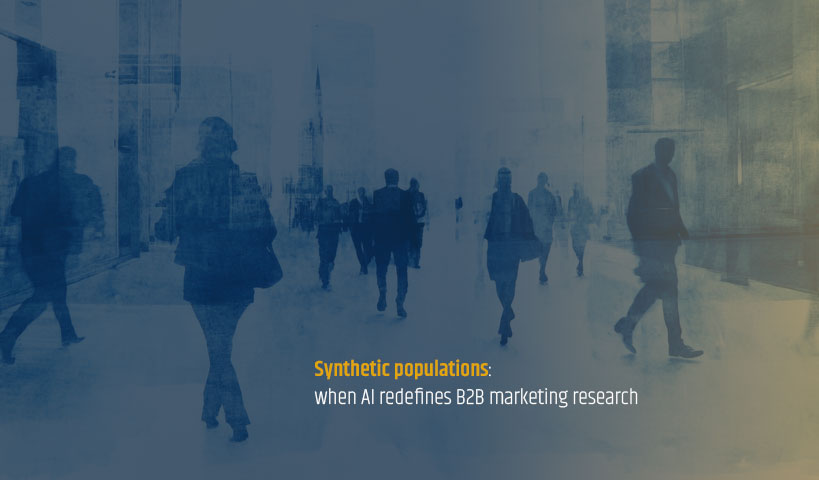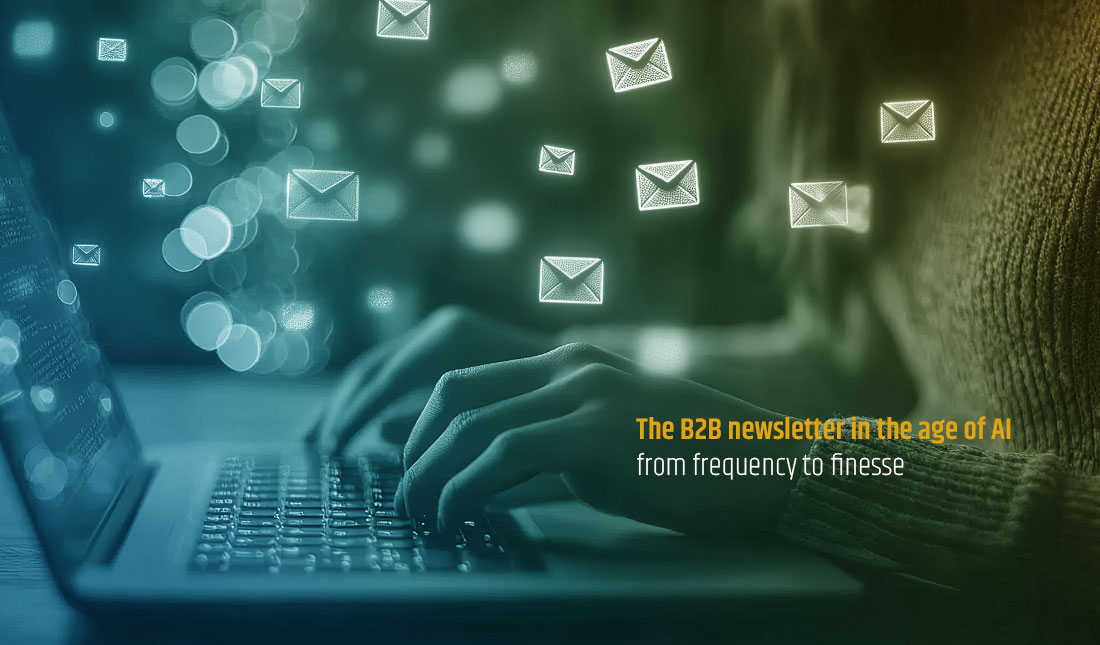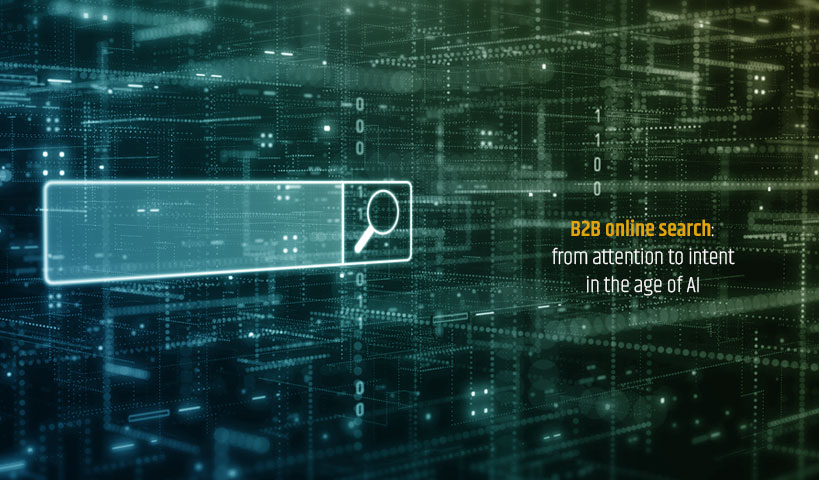
What if your customers could speak… even before they existed? What was once the stuff of science fiction is now one of the most innovative marketing tools available. Thanks to synthetic populations, it is now possible to simulate conversations, test messages, and gather feedback even before a product is launched or the first line of code is written. No more waiting weeks to assemble a focus group: these realistic, AI-generated avatars are ushering in a new era of fast, agile, and credible customer behavior exploration.
At ExoB2B, we have been conducting qualitative and quantitative research for 23 years. For us, understanding the real drivers of decision-making, what customers think, feel, or fear, has always been at the heart of the strategies we design. And even if the word “research” sometimes evokes traditional methods such as surveys or focus groups, the reality is quite different: research is alive and evolving with tools, markets, and contexts.
In recent months, we have therefore begun to seriously explore the contribution of artificial intelligence to this process. First with curiosity, then with method. And we have discovered a powerful complementarity: between human intelligence and synthetic intelligence, between reality and projection, between listening in the field and assisted simulation. Synthetic populations, in particular, have caught our attention.
In the B2B marketing context, where respondents are rare, where every customer counts, and where decision-making processes are complex, synthetic populations are changing the rules of the game. They offer you a unique way to capture market signals, explore hypotheses, validate messages… all before even requesting a first meeting.
What are synthetic populations?

Synthetic populations are groups of individuals simulated by artificial intelligence, but which faithfully reproduce the behaviors, characteristics, and decisions of a real population. These “people” do not exist in reality, but are constructed from a combination of very tangible data: demographic statistics, online behavior, transaction histories, CRM data, and even results from past surveys.
What makes these virtual individuals credible is their statistical consistency. For example, if an IT director in an industrial SME tends to hesitate when faced with cloud solutions without proof of security, a synthetic avatar can express exactly this type of reluctance in a marketing message test.
Once reserved for disciplines such as urban planning, economic modeling, and public health, synthetic populations have found a new field of application in B2B marketing thanks to rapid advances in artificial intelligence. Generative models such as ChatGPT now make it possible not only to create diverse profiles, but also to bring them to life in scenarios: reading a value proposition, simulating a purchasing process, reacting to an advertising message, etc.
Why is this revolutionary for marketing research?
1.Agility and speed
No more long recruitment delays, forms to fill out, or liaison officers to mobilize. A synthetic population can be generated in minutes, allowing you to simulate the reaction of dozens of typical profiles ahead of a campaign. This ability to “pre-test” your ideas gives you an unparalleled advantage in terms of speed of execution.
Better yet, you can compare the reactions of different segments (current customers vs. potential customers, skeptics vs. enthusiasts, etc.) in a single simulation cycle. This makes your strategic thinking more agile, your decisions faster, and your campaigns more relevant from the outset.
2. Granularity and control
Unlike traditional panels, synthetic populations are not limited by the realities on the ground. You can create highly specific micro-segments, such as IT managers in small and medium-sized businesses in the Eastern Townships who already use open-source ERP software and are looking for a cybersecurity solution.
Each variable can be adjusted: level of digital maturity, attitude toward innovation, typical objections, decision history. This gives you insights of a precision rarely achieved in traditional research, without compromising on profile diversity.
3. Real data protection
Another significant advantage is that these populations are not based on any personally identifiable data. You work with statistical models, not real individuals. This eliminates any issues related to privacy or data security.
In a context where compliance requirements (such as Quebec’s Bill 25 or the GDPR in Europe) are becoming increasingly strict, this approach allows you to stay on the right side of ethics while extracting strategic value from your existing data.
Can synthetic populations really replace control groups and surveys?
Yes… and no.
| What it can replace | What it doesn’t completely replace |
| Exploratory testing | The human emotional experience |
| Large-scale validation | Real interaction between individuals |
| Behavioral analysis | Nonverbal language, cultural nuances |
| Impact simulations | Co-creation, interactive workshops |
In a B2B marketing context, where panels are often small, costly, and unrepresentative, synthetic populations are a godsend. Above all, and in my humble opinion, they should be combined with field validation or targeted qualitative analysis.
In B2B marketing, where every customer counts and panels are often limited, this ability to simulate audiences becomes a strategic lever. It allows you to test, adjust, and predict while circumventing the logistical and budgetary constraints of traditional methods.
Where AI falls short, humans take over
Let’s be clear: no matter how sophisticated it may be, artificial intelligence cannot replace human judgment, intuition, and experience. Synthetic populations can tell you what a B2B customer might think. But they will never know for sure what they really feel.
They don’t perceive awkward silences during an interview. Or don’t pick up on doubt in a glance, hesitation in a response, or the warmth of sincere enthusiasm. They don’t understand the dynamics of a decision-making team, the implicit power games, or the organizational culture specific to each company.
So, after exploring, testing, and filtering your ideas with AI, it becomes essential to take up the torch again. In the field, with real people. Where subtlety and empathy make all the difference.
Thus, the most effective approach remains hybrid. You start with AI to test, explore, and reduce uncertainty. Then you move to the field to validate, adjust, and feel.
Why sythetic populations are strategic in B2B marketing
B2B marketing is not about volume. Here, every relationship counts. Every interaction carries weight. And every mistake can be costly in terms of time, money, and credibility. You are not talking to thousands of anonymous consumers, but to a few dozen or a few hundred highly strategic decision-makers.
These often involve purchasing committees, long cycles, and complex technical and financial issues. And getting an interview, comment, or feedback in this context is a rare privilege. As a result, simulating scenarios with synthetic populations becomes a particularly valuable option.
This allows you to test messages, anticipate reactions, identify typical objections… even before engaging in a first real conversation. It is a tool for preparation, precision, and efficiency.
In this context, the synthetic population becomes a tool for precision. It allows you to simulate, understand, anticipate… without already mobilizing your entire sales team.
Conclusion: Synthetic populations are a powerful ally, not a substitute
Synthetic populations are not there to replace your teams, analysts, or experts. They are there to reinforce them. To accelerate your thinking, broaden your perspectives, and test your intuitions.
At ExoB2B, we believe that the best decisions emerge when artificial intelligence and human intelligence work hand in hand. This allows you to move faster, yes, but above all to aim more accurately.
Are you about to launch a new product? Explore a new market? Think about your B2B marketing positioning? What if we simulated it before launching for real? Contact us. We’ll introduce you to your customers before they even know you.
Frequently asked questions
1- Are synthetic populations only for large companies?
Not at all. Thanks to artificial intelligence tools such as ChatGPT and Claude, this approach is now accessible to SMEs. All you need is a solid foundation (such as your personas, CRM data, or survey results). At ExoB2B, we already use these tools in projects of various sizes, with concrete and actionable results.
2- What is the difference between a persona and a synthetic population?
A persona is a typical profile derived from qualitative research, often static. A synthetic population simulates behaviors, reactions, and decision-making based on this persona in concrete scenarios. It is a dynamic way to test your marketing hypotheses before going into the field.
3- Can you really test a marketing message with virtual customers?
Yes, absolutely. A synthetic population allows you to simulate the reaction of a target profile to a message, value proposition, or campaign. It’s a quick and structured way to validate your communication angles, while avoiding mobilizing your real contacts too early in the process.




